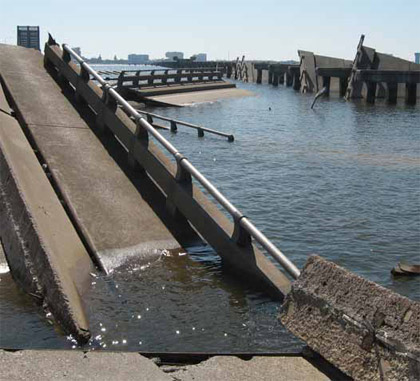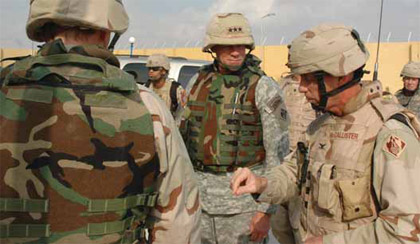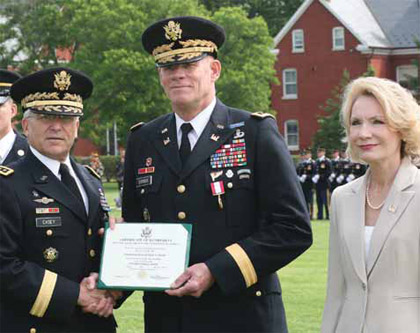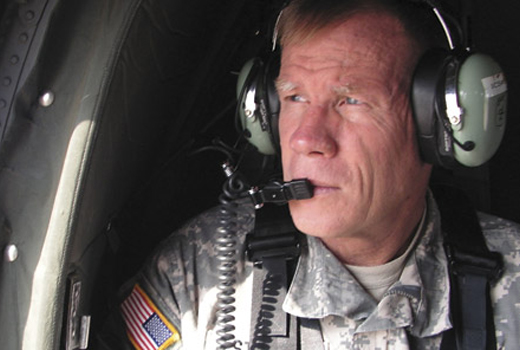Lieutenant General Carl Strock: A General’s Journey From Katrina & Iraq to Sustainability
Upon first glance, Lieutenant General (LTG) Carl A. Strock, the 51st Chief of Engineers and Commander of the U.S. Army Corps of Engineers (USACE), doesn’t embody the stereotypical retirement story – no frocks of white hair, no wrinkled visage. To the contrary, Strock’s youthful appearance, tanned skin and short, well-kept, darkened-blond hair all defy the classic retirement story. Nevertheless, Strock retired on May 17, 2007, in a ceremony hosted by General George Casey, Jr., Army Chief of Staff. The occasion provided a capstone sendoff for Strock, who served more than three years of his four-year term as Commanding General. As the three-star general was on the cusp of crossing into this period of respite, he sat in his chair on May 7 at the Washington, D.C. USACE Headquarters to discuss his experiences and event-filled career. Wearing a tailored set of camouflaged fatigues, Strock leaned forward – poised, polished and professional – expressing his trademark confidence, charisma and engaging smile.
Many would not expect this combination of ease and self-confidence on the face of a leader whose organization the media has relentlessly criticized for two of the most polarizing, unpopular events of the Bush Administration: Hurricane Katrina and the war in Iraq. But Strock’s career is defined by more than public opinion and perception of both events. In fact, as Strock explains it, with an American flag and USACE flag framing his figure, the Corps and he have a mission that extends far beyond the common divisiveness of politics – a mission that is effectively and proudly centered on sustainability. So much so, in fact, that the Chief declared in no uncertain terms, “We’re absolutely committed to it!”
The Scenic Route
Born in Georgia to an Army family, Carl Strock sought a future steeped in patriotism and public service. Like so many children of career officers, Strock entered Virginia Military Institute (VMI) after high school graduation. But, as destiny would have it, he left before graduating.

© iStockphoto.com/johnandersonphoto
As a result, he found his way into the Army as a Vietnam War draftee, who carefully cultivated his craft as an infantry enlisted man until he was accepted into Officer Candidate School (OCS). Following OCS graduation in 1972, Strock received his commission as an infantry second lieutenant. “I think I’m the only Chief of Engineers who had enlisted time,” Strock said proudly. “It’s been useful, I think.“Understanding that education and training are keys to knowledge and advancement, Strock volunteered for Airborne, Special Forces and Ranger training. Regarding the Ranger tabs on his fatigues, Strock explained that Ranger School “uses the smaller unit patrol as a vehicle to teach leadership . . . it puts you under tremendous stress – physical and mental – and then puts you in leadership positions.”
Eventually, in 1975, Strock graduated from VMI with a civil engineering degree, which was eventually accompanied by a Master’s degree in civil engineering from Mississippi State University – an educational and career shift that placed him on a path toward the Army Corps of Engineers. “I was attracted by the Corps’ history and reputation and asked to transfer to the Engineers when I saw that, in both peace and war, this organization makes a positive difference for the Nation every day,” Strock explained.
He became the 51st Chief of Engineers – a leader who commands the largest public engineering, design and construction management agency in the world – in 2004. Upon being promoted to this position, Strock recalls the Army’s Vice Chief of Staff’s describing the former’s trek toward Corps leader as “the scenic route.” Regardless of how he got there, it was in this position that Strock inherited a post-9/11 world, a growing war in Iraq, the rebuilding of Afghanistan and, eventually, a devastated Gulf Coast following Hurricanes Rita and Katrina. “It has certainly been eventful,” said the Chief.
Inherit the Earth
When the average citizen conjures up images of the U.S. Army Corps of Engineers, dam building and levee proposals are usually what come to mind. But the Corps, comprised of 34,600 civilians and 650 military personnel worldwide, is much more, running deeper than the waterways they pledge to protect and to make navigable. In fact, the Corps’ myriad and diverse responsibilities are so vast they boggle the mind. Within the United States alone, the Corps has built more than 606 dams and manages 456 water resource projects covering an aggregate of more than 11.5 million acres. According to the Corps, their water resource recreation sites have more visitor days than either the National Parks or National Forests. “Nearly 400 million visitors annually enjoy fishing, hunting, swimming and other water-related sports at Corps recreation areas,” revealed USACE Director of Civil Works, Major General Don T. Riley.
Historically, the Corps, a permanent institution since 1802, was among the first to recognize the need for protection of natural resources and, in fact, the U.S. Army Corps of Engineers safeguarded one of the few surviving buffalo herds. In addition, the Corps was influential in creating and developing America’s first national park, Yellowstone, in 1874 and kept watch over the Nation’s jewel until creation of the National Park Service in 1918. Domestically and internationally, the Corps is America’s earth steward, on a constant vigil to provide research and protection for projects as diverse as the polar ice caps through their Cold Regions Lab to assisting with water development in Africa via their internationally renowned Water Resources Institute.

© iStockphoto.com/ssucsy
In addition, one of the Corps’ main missions is to assist and protect U.S. war fighters internationally, including those in Iraq and Afghanistan. As part of this assignment, the USACE is responsible for engineering, environmental management and construction – oftentimes serving as the stabilizing force during conflict by creating a safely engineered environment for both troops and allies.
As such, the earth over which LTG Strock assumed command as the Chief of Engineers reflects a constantly evolving world. But his tenure, according to some, may be unique because of a series of events never before experienced – flood waters and gale winds crumbling man-made structures, fundamental terrorists’ and radical insurgents’ destroying Corps-built infrastructure and climate change becoming mankind’s most pressing concern.
Designed To Get Beat Up On
Rather than applauding the Corps for their ongoing and significant achievements, the world that Strock inherited was eager to blame the Corps for their shortcomings – many of which are limitations within the Corps’ very design. “In every case, we do only what we are empowered to do by the Congress,” Strock said. “That’s one of the things that sets us apart from the person on the street. If there’s something you want to do and there’s no law against it, you can go do it. But as a public servant, I have to be specifically empowered to do something. So I’ve got to find a law that allows me to do what it is I want to do.”
In fact, LTG Bob Flowers, Strock’s predecessor and fellow VMI graduate, said, “The Corps was designed to get beat up on.” As Flowers explained, the USACE lacks both Cabinet-level representation as well as the independent authority to tackle obstacles without federal oversight and regulation. “That’s how we’re designed,” Strock, concurring with Flowers, commented.
However, while the Corps may seem distant to many citizens, an organization for which there is often little praise and much finger-pointing, Strock believes the limitations of its design may actually benefit voters. “I (the Corps) am sometimes limited by the way laws are written (by Congress), and I am told that I have to do things,” Strock said. “So, to an extent, the Corps has been carrying out the will of the people.”
But Strock doesn’t place the onus of responsible decision-making solely on Congressional representatives, whose choices sometimes have massive social, human and environmental repercussions. Instead, Strock believes in balance among the various entities involved. “Now, I don’t want to completely hide behind that and say ‘well, we did it because we were told to do it’ because we certainly have the ability to influence the decisions that are made in that body,” Strock said.
As a result, the Corps often presents Congress with studies, findings and information. Strock reiterated, “We do what we’re told to do; but, we can also influence the direction of policy in the long run.”
A Mission of Sustainability & Balance
Much like people, the Corps itself is not a perfect entity. For every dam built, levee created or project completed, there is an impact on the environment and the world around it, with the results often causing dissent from Corps critics.
“In our 200-year history, science, technology and our understanding of the environment have obviously improved significantly. In many cases we did things without really understanding the consequences. However, there were situations where we knew there would be negative environmental or social consequences, but the projects were constructed anyway to serve a greater national need at the time. Now we have the ability to better understand all the outcomes because we’ve seen the manifestation of those consequences and we can better predict what those consequences might be,” Strock said. In all cases, the Corps’ general approach is to avoid damage, minimize that which cannot be avoided and mitigate the remainder.
Through much of the Corps’ past, the goal was unbalanced: The mandate was to focus more on economic gains and less on environmental impacts. However, time has tempered the scales of both economic and environmental interests. Under the direction of the 50th Chief of Engineers, LTG Bob Flowers, the Corps unveiled the “Environmental Operating Principles” (EOP), signed by then-Chief Flowers, with Strock in attendance at a 2001 Earth Day Celebration. The EOP outline environmental tenets and Corps goals, such as “strive to achieve environmental sustainability,” “seek balance and synergy among human development activities and natural systems” and “accept corporate responsibility and accountability under the law for activities and decisions under our control that impact human health and welfare.”
Even after Flowers’ term ended in 2004, Strock rallied behind these principles and continued the Corps’ drive toward sustainability. According to Strock, the EOP serve two purposes: one, public; one, private. To Corps workers and staff the EOP have become a mission statement of sorts. “We want our employees to have an environmental ethic, a sustainability ethic,” he said. To the public the EOP act more as a notice. “I also say to external audiences ‘this is a report card. If you see us acting inconsistent with these principles, bring it to my attention,’” Strock said.
However, both Strock and Flowers note that this environmental interest-balancing approach isn’t new; it has been core to the Corps since the beginning. For example, in the 1930s, Strock said, the Corps was involved in projects throughout the Columbia River. During this time fish ladders were created “because we understood we had to have some way to continue that natural process of migration of salmon up and down the river,” Strock said. And, according to him, over time the USACE has adapted by creating more sustainable and environmental approaches that have increased the number of passages for migrating fish.
Truly effective environmental sustainability is “a combination of responding to things already happening and trying to shape things” that have yet to occur – a mission of balance, according to Strock. But the Chief believes sustainability is also about correcting past indiscretions and mistakes. “We did know in some cases that there would be environmental impacts,” Strock said. “We’ve also made a commitment in our strategic plan to look back at what occurred and where we can . . . restore any damage we have caused to the environment.”
Katrina: Understanding Risk
While the push for sustainability is a unifying plus, the USACE has faced issues of a divisive nature. When LTG Flowers was asked to comment on Strock’s tenure as Chief, he stated quite simply, “Carl’s had it tough.” And among the reasons for it being so “tough” were the war in Iraq and the rebuilding of New Orleans after Hurricane Katrina. “I’ve been very proud of the way they responded,” Flowers said. “Other parts of the government would have totally been brought to their knees. The Corps wasn’t, and that’s thanks to Carl Strock.”

© iStockphoto.com/jhgrigg
Some critics, though, have been less complimentary. Following levee failures in New Orleans, the city sued USACE for more than $75 billion and placed full responsibility on the Corps. Strock disagrees with their assessment of the Hurricane Katrina tragedy.
“When I hear that people in New Orleans lost their lives because the Corps of Engineers decided to build a levee, that’s nonsense,” Strock said, the pitch of his voice changing. “Now I don’t want to get into a public debate about it, but that’s nonsense. We built the levees at the request of local authorities because they wanted to expand the development of the city of New Orleans; that was a decision made by others, and we carried out that decision.”
According to Strock, “There is an understanding that if the surge exceeds the capacity of the levee, then water is going to come over the levee, and people are going to be in jeopardy. If the event is stronger than that, then we assume the area has been evacuated because people understand flood level protection.”
Strock blames levee failures and overtopped levees, as well as a spotty evacuation on behalf of the city, for “a lot of loss of life.” In such cases, the reliance cannot be placed solely upon man-made structures susceptible to the unpredictable forces of nature and time; instead, evacuations must be heeded. There will always be an inescapable risk, Strock said.
“We think our job is to contribute to informed decisions. That informed decision-making can happen in the halls of Congress, or it can also happen in the mind of a homeowner in the lower Ninth Ward,” Strock said. “We have an obligation to let each person know we will afford a certain level of protection and that there is still some residual risk. And they need to understand that risk as they make decisions about whether to build or not. We have an obligation to explain that risk in terms that can be understood by the general public.”
One major difference that Strock has cited since Katrina is the Corps’ attempt to add loss of human life to the risk equation: “What if I tell you the economic risk is $100 million and the human risk is four lives? What is a human life worth?”
Despite the political fallout that came from Katrina, Strock still believes the tragedy’s outcome is important to his legacy as Chief. “I would like to be remembered as the public official who responded to the terrible tragedy of Hurricane Katrina by effectively informing the public, avoiding finger pointing and, after rigorous analysis, accepting accountability for the Corps’ contribution to the loss of life and property,” Strock said.
Iraq: Blowing Up Schools & Building Hospitals
A less contentious but equally visible task during Strock’s tenure has been rebuilding the Iraqi infrastructure and supporting the war fighters in the Global War on Terror (GWOT). “Remarkably,” Strock continued to comment, “we haven’t gotten a lot of heat on what the Corps is doing there because I think everyone recognizes the work is necessary and right and good. They also understand that it is a very difficult environment.”

Photo by U.S. Army Corp. of Engineers
In Iraq the Corps assists U.S. and allied troops in their GWOT mission in addition to reaching out to Iraqi people by providing for their basic infrastructure needs, such as electricity, potable water and sanitation while also providing for basic societal needs like healthcare and education. “We’re putting much more effort into working in the Iraqi communities than we have in previous wars,” Strock said. In addition, by utilizing Iraqi workers, the Corps hopes to provide economic benefit to disenfranchised Iraqi families while, at the same time, taking advantage of their excellent engineering and construction skills.But this relationship is weakened and strained because of insurgents’ using intimidation with Iraqi contractors working with the Corps. “That’s part of the reason our work is so difficult – because the enemy knows that and, as quickly as we make something, they destroy something. They’re destroying schools . . . sometimes they do it before a ribbon-cutting. They’ll blow the school up just as we’re beginning to occupy it. Sometimes they’ve done it after the school is occupied when children are there. We face a ruthless and a very sophisticated enemy who watches our every move,” Strock said.
At the end of the day, though, Strock believes Corps members risk their lives to bring hope, stability and a much-needed infrastructure to lives of Iraqi citizens – an effort he considers humanitarian. One of the Corps’ newest projects is a 94-bed children’s hospital, which will specialize in children’s cancer research and treatment; it is scheduled for completion in 2008. The hospital is being built in Basrah principally because children under age 5 in southern Iraq suffer a high mortality rate from cancer; this is one of the more than 140 USACE medical construction projects in Iraq.
“The people look for essential services,” Strock said. “They want a quality of life . . . they did not enjoy a high quality of life across the board under Saddam (Hussein), and they have great expectations that we’ll provide a better quality of life.”
An Officer and a Gentleman
Strock has an interest in all aspects of his inherited earth – environmental, human and economic. When it comes to sustainability, LTG Flowers believes Strock used the EOP effectively and that he has “taken them to heart” – something he may have done in the literal sense.

Photo by U.S. Army Corp. of Engineers
An example of this is Cadillac Heights, a low-income African American community susceptible to flooding outside Dallas, Texas. From an economic perspective, it is a community not worth saving when compared to costs of levees needed to protect it. “The right thing to do, economically, is to buy people out and relocate them and not try to protect that city because it’s going to cost more to protect it than the structures behind the levee would be worth,” Strock said.But in Strock’s world there is more to worth than dollars; worth has a deeper social and moral significance: “The problem with that is, if you pay people for the value of their homes, as you must, at fair market value, and I give you $40,000 for your modest house in Cadillac Heights, where are you going to find a place to live in Dallas, Texas, that allows you access to the schools, jobs and that sort of thing that Cadillac Heights now has?” Strock posed rhetorically.
Strock, a leader and an American hero to those who know him, has given his life to the service of others and to the environment. Through years of experience and dedication, he knows there are no clear-cut answers – that every component of decision-making is a balancing act among a myriad of interests. But, to Strock, one interest has the potential to trump all others – it is an interest of the heart that leads to the sustainability of family and community.
“As modest as it is, Cadillac Heights residents have generations invested there. This community was their grandfathers’ and great-grandfathers’. This is their families’ and friends’, and they don’t want to give it up. There is an intrinsic value there,” Strock said. “The Corps will protect Cadillac Heights even though it doesn’t make sense economically.”
Whether leading the Corps to find solutions that save communities like Cadillac Heights or saving the pallid sturgeon from extinction, Strock is the type of commander who balances his confidence with compassion and who displays a leadership style that has created a career of great achievement – one that inspires and serves as an example to those who follow.
True heroes don’t look for what they can get; they look for what they can give. And LTG Carl Strock, the 51st Chief of Engineers and Commander of the U.S. Army Corps of Engineers, has given much and has asked for nothing in return. It is these character-enriched actions that have led people like LTG Flowers to confidently say “he is an officer and a gentleman in the finest sense.”





























